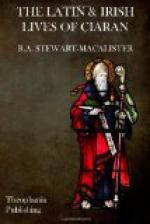Versions of the Tale.—It would appear that this story was originally an account of how Ciaran and his distant tutor could communicate, quite independent of incident VI. It has become awkwardly combined with VI into a conflate narrative, as is shown by the silence about the fox in LA. According to the one story, they used their supernatural “wireless telephone.” According to the other, the fox trotted back and forth with the book. In the conflate version, it would appear that Iustus dictated Psalms to Ciaran by “telephone,” Ciaran then wrote them on his tablets, and the fox waited till he was finished and then carried them for correction to Iustus. (As is observed in the footnote in loc, p. 73, we must read “Iustus” for “Ciaran” in the passage describing the proceedings of the fox).
The Homiletic Pendant.—The unexpected homiletic turn given to this story in VG may perhaps find its explanation in facts now lost to us; the passage reads like a side-thrust at some actual person or persons. It may possibly refer to the act of sacrilege committed by Toirdelbach o Briain, in 1073, who carried away from Clonmacnois the head of Conchobar o Maeil-Shechlainn; but being attacked by a mysterious disease—imparted to him, it was said, by a mouse which issued from the head and ran up under his garment—he was obliged to return it, with two gold rings by way of compensation. He did not recover from the disease, however, but died in 1086 (Annals of Four Masters).
VIII. HOW CIARAN SPOILED HIS MOTHER’S DYE (VG)
I have found no parallel to this most remarkable story. It displays the following noteworthy points—
1. It belongs to the Ciaran-tradition which places the home of the family in Cenel Fiachach.
2. It preserves what has every appearance of being an authentic tradition of a prohibition against the presence of males, even of tender years, when dyeing was being carried on.[12]
3. Most likely the saint’s curse—indeed, the whole association of the tale with Ciaran—is a late importation into the story: it was probably originally a [Pagan] tale, told as a warning of what would happen if males were allowed to be present at the mystery. The different colours which the garments assumed are perhaps not without significance; Sullivan, in his introduction to O’Curry’s Manners and Customs (i, p. 405), says “the two failures ... are simply the failures which result from imperfect fermentation and over-fermentation of the woad-vat.”
4. There is an intentionally droll touch given to the end of the Maerchen.
5. The independence of parental control which the youthful Ciaran displays will not escape notice.
The Stanza.—This is written in a peculiar metre; two seven-syllable lines, with trisyllabic rhymes, followed by two rhyming couplets of five-syllable lines with monosyllabic rhymes.




